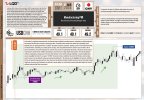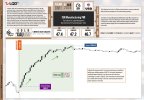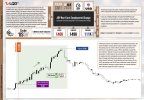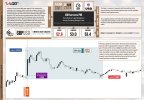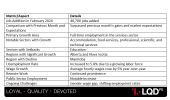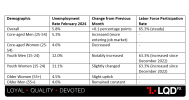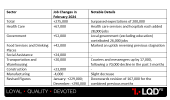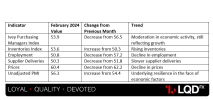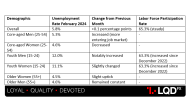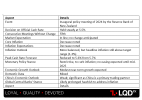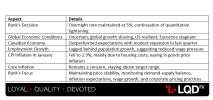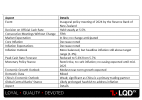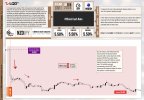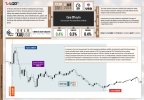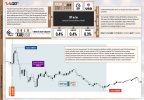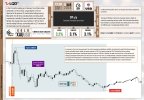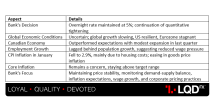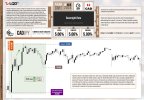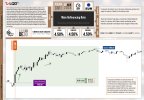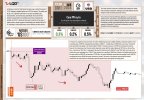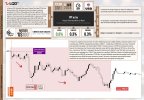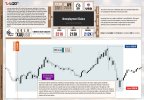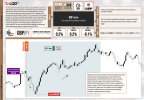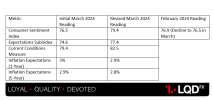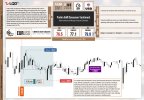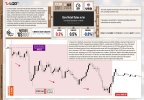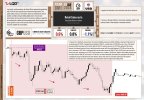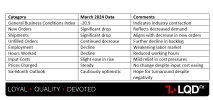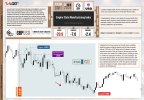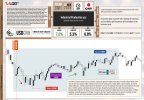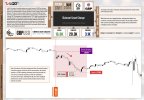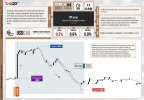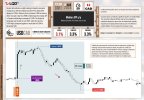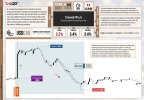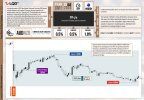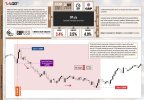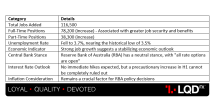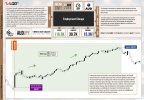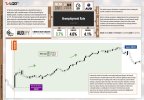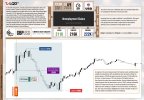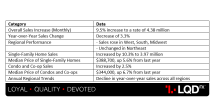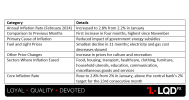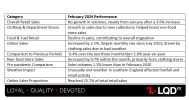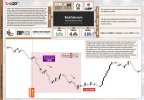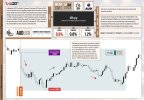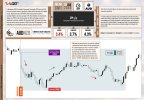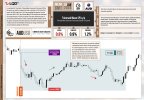Daily News Update
23 April 2024
Tuesday
Tuesday is poised to be a vital "moving day" for financial markets, marked by several crucial data releases. The day starts with Japan's JFlash Manufacturing and Services PMI, expected to have a medium impact. This will be followed by high-impact PMI announcements from France and Germany, potentially influencing market dynamics significantly. The Euro Zone will also release its Flash Manufacturing and Services PMI, with a predicted medium impact. In addition, Great Britain and the United States are set to announce their respective Flash PMIs, anticipated to strongly affect the markets. The U.S. will further update on New Home Sales and the Richmond Manufacturing Index, both expected to have a moderate impact. These releases are likely to incite notable market volatility and could dictate market trends in the subsequent days.
JPY - Flash Manufacturing PMI
The Flash Manufacturing Purchasing Managers' Index (PMI) is a key economic indicator derived from a diffusion index based on surveys of approximately 400 purchasing managers in the manufacturing sector. It serves as a leading indicator of economic health because purchasing managers offer timely and relevant insights into the business conditions at their companies. Generally, a PMI score above 50.0 indicates industry expansion, whereas a score below 50.0 signifies contraction. The PMI is particularly noteworthy because a reading that exceeds forecasts usually benefits the currency value. This index is released monthly, around three weeks into the current month, and comes in two versions: Flash and Final. The Flash version, which was first introduced in May 2014, is released first and tends to have a greater impact due to its timeliness. Respondents in the survey evaluate various aspects of business activity including employment, production, new orders, prices, supplier deliveries, and inventories. This index is also referred to as the Jibun Bank Manufacturing PMI.
In March 2024, the au Jibun Bank Japan Manufacturing PMI indicated a slight improvement in factory conditions despite marking the tenth consecutive month of contraction with a score of 48.2, holding steady from preliminary estimates and up from February's low of 47.2, the weakest since August 2020. The decline in factory activity was the most modest since November, buoyed by less severe reductions in production and new orders, the latter of which decreased at the slowest pace in five months. Additionally, manufacturing employment grew for the first time in three months, achieving the strongest expansion since July, although work backlogs dropped nearly at a record pace in the ongoing 18-month period. Purchasing activity also declined less sharply than in previous months, and delivery times lengthened further due to disruptions in the Red Sea and Panama Canal. On the financial side, input costs rose at the slowest rate since February 2021, but selling prices climbed to a three-month peak. Despite the challenges, business sentiment remained optimistic, fueled by expectations of renewed domestic and global demand.
TL;DR
| Metric | Detail |
| PMI Score | 48.2 (tenth consecutive month of contraction, up from February's 47.2) |
| Factory Activity | Least decline since November; less severe reductions in production and orders |
| New Orders | Decreased at slowest pace in five months |
| Manufacturing Employment | Grew for first time in three months, strongest expansion since July |
| Work Backlogs | Dropped nearly at a record pace over last 18 months |
| Purchasing Activity | Declined less sharply than previous months |
| Delivery Times | Lengthened due to disruptions in Red Sea and Panama Canal |
| Input Costs | Rose at slowest rate since February 2021 |
| Selling Prices | Reached a three-month high |
| Business Sentiment | Remained optimistic, driven by expectations of renewed domestic and global demand |
The forecast for the
Flash Manufacturing PMI suggests an improvement, with a projected reading of
48.9 compared to the previous outcome of
48.2.
JPY - Flash Services PMI
The survey encompasses various sectors including transport and communication, financial intermediation, business services, personal services, computing and IT, as well as hotels and restaurants. To ensure accurate representation, each response is weighted based on the size of the company and the sector's contribution to the overall service sector output. This weighting method prioritizes feedback from larger companies, allowing them to have a more significant influence on the final index numbers than smaller companies. The results are displayed by each question asked, indicating the percentage of respondents who reported an improvement, deterioration, or no change compared to the previous month. An index is then calculated from these percentages where a score of 50.0 indicates no change from the previous month. Scores above 50.0 denote an improvement, while scores below 50.0 indicate a deterioration. The further the score deviates from 50.0, the stronger the indicated rate of change.
In March 2024, the au Jibun Bank Japan Services PMI was adjusted downward to a seven-month peak of 54.1 from a preliminary estimate of 54.9, which had been the highest in ten months. This adjustment still represents an improvement over February's index of 52.9, marking the 19th consecutive month of expansion within the service sector. This growth has been supported by increasing demand and a rise in customer numbers. Although the pace of employment growth moderated slightly from February, it continued to exceed the long-term average for the series. On the pricing side, input costs rose to a five-month high, driven primarily by increases in fuel, labor, and utilities prices, leading to a slight rise in selling prices. However, the rate of price inflation remained relatively stable compared to February. Business sentiment continued to be strong, fueled by optimism for a widespread economic recovery that could enhance customer demand.
TL;DR
| Metric | Detail |
| PMI Score | Adjusted to 54.1 from preliminary 54.9, highest in seven months, up from February's 52.9 |
| Consecutive Expansion | 19th consecutive month of expansion in the service sector |
| Demand and Customers | Increased demand and rising customer numbers support growth |
| Employment Growth | Moderated slightly from February but continued to exceed long-term average |
| Input Costs | Rose to a five-month high, driven by increases in fuel, labor, and utilities prices |
| Selling Prices | Slight rise, with rate of price inflation remaining stable compared to February |
| Business Sentiment | Strong, fueled by optimism for a widespread economic recovery enhancing customer demand |
The forecast for the Flash Services PMI is set at
54, slightly below the previous reading of
54.1.
According to the scoring system, any score
above 50.0 signifies an improvement in conditions, while a score
below 50.0 indicates a deterioration. Thus, despite the slight decrease, the forecasted index of 54 still reflects an overall improvement in the service sector.
The upcoming release of the
Flash Manufacturing &
Services PMI is scheduled for
Tuesday at 12:30 AM GMT.
EUR – French Flash Manufacturing PMI
The Purchasing Managers’ Index (PMI) is a monthly indicator of economic health for the manufacturing sector, calculated from surveys conducted with purchasing managers. This gauge reflects industry conditions, where a PMI above 50 suggests growth, and a value below 50 indicates decline. It features both “Flash” and “Final” versions; the “Flash” PMI often impacts markets more significantly as it is released earlier. As a critical leading indicator, the PMI offers insights into business conditions and sentiment, drawing on the perspectives of approximately 750 participants concerning employment, production, and other business activities.
In March 2024, the S&P Global France Manufacturing Purchasing Managers’ Index (PMI) initially recorded a downturn with a ‘Flash’ estimate of 45.8, indicating a continued contraction, but was later revised upward slightly to 46.2. This adjustment still reflects the 14th consecutive month of decline in the French manufacturing sector, down from February’s reading of 47.1. Despite the persistent downturn, the sector experienced the slowest decrease in output since the escalation of geopolitical tensions with Russia two years ago, aided by some firms managing backlogs and initiating restocking efforts. However, the contraction in new orders intensified, leading to job reductions by not renewing temporary contracts. While input costs rose, the increase in selling prices was the smallest in over three years. Looking forward, the sector remains optimistic, anticipating better economic conditions and a boost in both domestic and international demand in the next 12 months.
TL;DR
| Metric | Detail |
| PMI Score | Revised to 46.2 from 'Flash' estimate of 45.8, indicating the 14th month of sector decline |
| Comparison | Down from February’s index of 47.1 |
| Sector Output | Slowest decrease since geopolitical tensions escalated with Russia two years ago |
| Management Actions | Some firms managed backlogs and initiated restocking efforts |
| New Orders | Contraction intensified, leading to job reductions by not renewing temporary contracts |
| Pricing | Input costs rose, but increase in selling prices was smallest in over three years |
| Business Sentiment | Remains optimistic, anticipating improved economic conditions and increased demand next year |
The forecast for the
French Flash Manufacturing PMI is reading
47, an increase from the previous actual of 46.2
The last time, the
French Flash Manufacturing PMI was announced on the 21st of March, 2024. You may find the market reaction chart
(EURUSD M5) below:
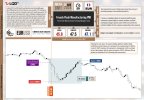
EUR – French Flash Services PMI
The Services Purchasing Managers’ Index (PMI) is a monthly diffusion index based on surveys from purchasing managers in the services sector, used to gauge the health of the industry. A PMI score above 50 indicates that the services sector is expanding, while a score below 50 suggests contraction. Introduced in March 2008, the “Flash” version of the PMI generally carries more impact than the “Final” release. As an important leading economic indicator, the Services PMI offers insights into business sentiment and market conditions through responses from approximately 750 managers, who provide data on employment, orders, and pricing.
In March 2024, the HCOB Flash France Services PMI initially reported a downturn, dropping to 47.8, signifying a continued contraction in the French services sector for the tenth consecutive month, below the expected forecast of 48.8. However, this figure was later revised upwards to 48.3, indicating a slightly less severe contraction than initially thought. The primary factors contributing to this persistent decline included reductions in activity and sales, driven by economic challenges and sustained inflationary pressures. Despite the downturn, there was a significant increase in employment, suggesting that companies are investing in their workforce to prepare for future demands. Additionally, input prices cooled to a 31-month low but remained high due to ongoing salary increases, while output prices decelerated. Norman Liebke from Hamburg Commercial Bank highlighted a delayed economic recovery, expected to continue into at least the second quarter. Nonetheless, there was a notable improvement in business confidence, supported by an optimistic outlook for the economy, which might indicate a gradual shift toward recovery despite the ongoing challenges.
TL;DR
| Metric | Detail |
| PMI Score | Revised to 48.3 from initial 47.8, indicating a less severe contraction than expected |
| Consecutive Contraction | 10th consecutive month of contraction in the services sector |
| Primary Factors | Reductions in activity and sales due to economic challenges and sustained inflation |
| Employment | Significant increase, indicating investment in workforce for future demands |
| Input Prices | Cooled to a 31-month low but remained high due to ongoing salary increases |
| Output Prices | Decelerated |
| Economic Outlook | Norman Liebke noted a delayed economic recovery expected to continue into at least the next quarter |
| Business Confidence | Improved, supported by an optimistic outlook for the economy |
The forecast for the
French Flash Services PMI is reading
49.1, an increase from the previous actual of 48.3.
The next release of the
French Flash Manufacturing and Services PMI is scheduled for
Tuesday at
7:15 AM GMT.
The last time, the
French Flash Services PMI was announced on the 21st of March, 2024. You may find the market reaction chart
(EURUSD M5) below:
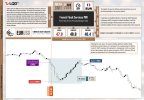
EUR – German Flash Manufacturing PMI
The Manufacturing Purchasing Managers’ Index (PMI) is a critical monthly indicator calculated from surveys conducted with 800 purchasing managers, designed to reflect the state of the manufacturing sector. Scores above 50 on this index suggest the sector is expanding, while scores below 50 indicate contraction. The PMI is published in two iterations, the “Flash” and the “Final,” which are released about a week apart. The “Flash” version, first introduced in March 2008, generally carries more weight. As a primary economic indicator, the PMI provides valuable insights into the manufacturing landscape by evaluating aspects such as employment, production, and new orders, based on input from professionals at the forefront of industry procurement.
In March 2024, the HCOB Flash Germany Manufacturing PMI initially reported a significant contraction in the manufacturing sector with a reading of 41.6, marking a five-month low and a decrease from February’s 42.5. This initial figure was later revised upwards slightly to 41.9, although it still indicated a strong deterioration in manufacturing conditions and the most considerable contraction in the past five months. The sector continued to struggle with faster declines in employment and stocks of purchases and a notable improvement in supplier delivery times, which suggested a diminishing impact from previous disruptions such as the Red Sea shipping issues. Despite the tough conditions, there were slower reductions in new orders and output, and a softening in the rate of decline for average purchasing costs, which was the weakest since the previous March. Conversely, average factory gate charges fell more sharply due to intense competition for new work. Amid these challenges, the updated data also reflected a slight improvement in sector sentiment, with manufacturers showing renewed optimism about growth prospects over the next 12 months.
TL;DR
| Metric | Detail |
| PMI Score | Revised to 41.9 from initial 41.6, marking the most considerable contraction in the past five months |
| Comparison | Decrease from February's 42.5 |
| Employment | Faster declines noted in employment and stocks of purchases |
| Supplier Delivery Times | Improvement, suggesting reduced impact from previous disruptions like Red Sea shipping issues |
| Order and Output Reductions | Slower reductions in new orders and output |
| Purchasing Costs | Softening in the rate of decline, weakest since the previous March |
| Factory Gate Charges | Fell more sharply due to intense competition for new work |
| Sector Sentiment | Slight improvement, with renewed optimism about growth prospects over the next 12 months |
The forecast for the
German Flash Manufacturing PMI is reading
42.9, an increase from the previous actual of 41.9.
The last time, the
German Flash Manufacturing PMI was announced on the 21st of March, 2024. You may find the market reaction chart
(DE30 M5) below:
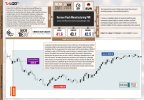
EUR – German Flash Services PMI
The Services Purchasing Managers’ Index (PMI) is an essential monthly diffusion index based on surveys of 800 purchasing managers, which assesses the performance of the services sector. A PMI score above 50 denotes expansion, whereas a score below 50 indicates contraction. Released in both “Flash” and “Final” versions about a week apart, the “Flash” release, first introduced in March 2008, is generally considered more impactful. As a prominent economic indicator, the PMI provides insights into the sector’s health by capturing purchasing managers’ evaluations of key business variables such as employment, orders, and prices.
In March 2024, the HCOB Flash Germany Services PMI initially indicated near-stagnation in the services sector with a preliminary reading of 49.8, up from February’s 48.3 and the highest in six months, suggesting the sector was nearing stabilization despite some ongoing challenges. This figure was subsequently revised upward to 50.1, marking the first actual stabilization in the sector after six months of contraction. The revised PMI reflects slight improvements in client interest and efforts in working through existing backlogs, coupled with strategic hiring that contributed to sustained job growth. While wage pressures continued to elevate input costs, there was a notable slowdown in the rates of inflation for both input prices and output charges compared to previous months. The inflow of new business saw its smallest decline since July, with a particularly moderate reduction in new business from abroad, signaling improving conditions. Moreover, business optimism reached its highest level since February 2022, driven by increasing confidence in a potential uplift in market conditions over the coming year.
TL;DR
| Metric | Detail |
| PMI Score | Revised to 50.1 from initial 49.8, marking the first actual stabilization after six months of contraction |
| Previous Comparison | Up from February’s 48.3, highest in six months |
| Client Interest & Backlogs | Slight improvements in client interest and efforts in working through backlogs |
| Employment | Strategic hiring contributed to sustained job growth |
| Wage Pressures | Continued to elevate input costs, though inflation rates for input prices and output charges slowed |
| New Business Inflow | Smallest decline since July, with moderate reduction in new business from abroad |
| Business Optimism | Highest since February 2022, driven by confidence in market conditions improvement over the coming year |
The forecast for the
German Flash Services PMI is reading
50.7, an increase from the previous actual of 50.1.
The upcoming
German Flash Manufacturing &
Services PMI is set to be released on
Tuesday at
7:30 AM GMT.
The last time, the
German Flash Manufacturing Services PMI was announced on the 21st of March, 2024. You may find the market reaction chart
(DE30 M5) below:
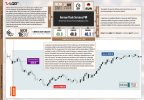
EUR – Flash Manufacturing PMI
The HCOB Eurozone Manufacturing PMI is a critical diffusion index derived from a survey of approximately 5,000 purchasing managers across the manufacturing sector. It is released monthly, usually three weeks into the current month. A PMI above 50 signifies expansion within the industry, whereas below 50 indicates contraction. This index is published in two forms: the “Flash” and the “Final.” The Flash version, first introduced in June 2007, is released about a week before the Final and typically has a greater impact due to its timeliness. The PMI is valued by traders because it’s a leading indicator of economic health—purchasing managers offer up-to-date and relevant insights on business conditions like employment, production, new orders, prices, supplier deliveries, and inventories. Generally, a PMI reading that exceeds the forecast suggests a positive outlook for the currency, reflecting stronger economic activity.
In March 2024, the HCOB Flash Eurozone Manufacturing PMI initially indicated a significant contraction in the manufacturing sector with a preliminary reading of 45.7, marking a noticeable decline from the previous month’s figure and reflecting ongoing challenges such as supplier delivery delays and changes in stocks of purchases related to earlier disruptions in the Suez Canal. However, this figure was later revised upward to 46.1. Despite this slight increase in the revised PMI, the reading still represented a three-month low for the sector. This revision suggests a marginal improvement in conditions compared to the initial estimate, including a slower contraction in manufacturing output, which has been declining for twelve consecutive months but at a reducing pace, reaching its slowest rate of decrease since April 2023. New orders and export sales also showed less severe declines than initially feared, with export sales recording their smallest drop in nearly two years, hinting at a potential easing of international market weaknesses. Business confidence in the manufacturing sector improved, reaching a high not seen in nearly a year, although growth expectations remained subdued, continuing to impact employment negatively within the sector.
TL;DR
| Metric | Detail |
| PMI Score | Revised to 46.1 from initial 45.7, marking a three-month low despite slight improvement |
| Previous Comparison | Noticeable decline from the previous month's figure |
| Manufacturing Output | Slower contraction, slowest rate of decrease since April 2023 |
| New Orders & Export Sales | Less severe declines than initially feared, with export sales having smallest drop in nearly two years |
| Business Confidence | Improved to a high not seen in nearly a year, but growth expectations remained subdued |
| Employment Impact | Continued negative impact on employment due to subdued growth expectations |
The projected forecast for the
European Economic Area Flash Manufacturing PMI is set at
46.5, showing a slight increase from the previous figure of
46.1.
EUR – Flash Services PMI
The HCOB Eurozone Services PMI is a crucial diffusion index derived from a survey of approximately 5,000 purchasing managers in the services industry, released monthly around the third week. Scoring above 50 indicates sector expansion, while below 50 signals contraction. The index is published in two editions, “Flash” and “Final,” with the “Flash” version—first reported in June 2007—being the earliest and most impactful release. This index serves as a leading economic indicator as it reflects real-time business reactions to market conditions, providing insights into employment, production, new orders, prices, supplier deliveries, and inventory levels. The PMI’s significance to traders lies in its ability to provide the most current and relevant evaluation of economic health, where an ‘Actual’ score exceeding the ‘Forecast’ is typically seen as positive for the currency.
In March 2024, the HCOB Flash Eurozone Services PMI showed a notable improvement, initially reported at 51.1 and later revised upward to 51.5, marking a significant rebound from February’s reading of 50.2. This increase indicates a stronger recovery in the services sector, with March’s figure representing the first expansion in service sales for the first time in nine months, primarily driven by a boost in domestic market orders. The sector also saw a continuation of job growth for the eighth month in a row, albeit at a slightly slower rate than in February, yet still above the long-term average. Additionally, the cost pressures that have been a concern in recent months showed signs of easing, with input costs rising at the slowest pace in eight months and output charges increasing at the most modest rate since November. Looking forward, the service providers’ outlook on business activity improved for the fourth consecutive month, reflecting growing optimism about future economic conditions.
TL;DR
| Metric | Detail |
| PMI Score | Revised to 51.5 from initial 51.1, marking a significant rebound from February’s 50.2 |
| Service Sales | First expansion in nine months, primarily driven by boost in domestic market orders |
| Employment | Continued growth for the eighth month, albeit at a slightly slower rate than February |
| Cost Pressures | Easing signs with input costs rising at slowest pace in eight months; modest rise in output charges |
| Business Outlook | Improved for fourth consecutive month, reflecting growing optimism about future economic conditions |
The forecast for the
European Economic Area Flash Services PMI is reading
51.8, a slight increase from the previous actual of 51.5.
The upcoming
Flash Manufacturing and
Services PMI is set to be released on
Tuesday at
8:00 AM GMT.
GBP – Flash Manufacturing PMI
The Manufacturing Purchasing Managers’ Index (PMI) is a vital diffusion index derived from surveys of approximately 650 purchasing managers, providing a monthly assessment of the manufacturing sector’s performance. A PMI score above 50 indicates the sector is expanding, while a score below 50 indicates contraction. The index is published in two versions: “Flash” and “Final.” The “Flash” version, which was first introduced in November 2019, typically has a greater impact because it is released earlier. As an important leading economic indicator, the PMI offers prompt insights into market conditions by analyzing purchasing managers’ perspectives on key business variables such as employment, production, and new orders.
In March 2024, the UK manufacturing sector exhibited signs of recovery, with the S&P Global Flash UK Manufacturing PMI initially reported at 49.9, up from February’s 47.5, and later revised upward to 50.3, marking the first expansion in the sector since July 2022. This turnaround is supported by the fastest rise in new orders since May 2022 and the first increase in production levels in a year, suggesting the end of a prolonged slump. The improvement was particularly notable in the consumer goods sector, which helped offset declines in other areas. Despite challenges such as high borrowing costs and supply chain disruptions, particularly from shipping issues in the Red Sea, optimism among manufacturers soared to an 11-month high, fueled by hopes for better supplier conditions and a global manufacturing revival. Although input costs remained high, reflecting ongoing inflationary pressures, the increase in output charges was modest, indicating that manufacturers are maintaining cautious pricing strategies in a competitive environment. This budding recovery in manufacturing, alongside continuous growth in the services sector, points to the potential for a broader economic rebound as the UK ends its strongest economic quarter since mid-2023.
TL;DR
| Metric | Detail |
| PMI Score | Revised to 50.3 from initial 49.9, marking the first expansion since July 2022 |
| New Orders | Fastest rise since May 2022, indicating recovery |
| Production Levels | First increase in a year, ending a prolonged slump |
| Sector Performance | Notable improvement in consumer goods sector offsetting declines elsewhere |
| Challenges | High borrowing costs, supply chain disruptions from Red Sea shipping issues |
| Business Optimism | Soared to an 11-month high due to better supplier conditions and global manufacturing revival hopes |
| Pricing Strategies | High input costs persist; modest increase in output charges reflecting cautious pricing strategies |
| Economic Outlook | Signs of broader economic rebound, supported by continuous growth in services sector |
The forecast for the
British Flash Manufacturing PMI is reading
50.5, a slight increase from the previous actual of 50.3.
The last time, the
British Flash Manufacturing PMI was announced on the 21st of March, 2024. You may find the market reaction chart
(EURGBP M5) below:
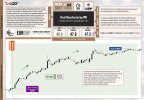
GBP – Flash Services PMI
The Services Purchasing Managers’ Index (PMI) is a crucial monthly diffusion index based on surveys from around 650 purchasing managers that assesses the health of the services sector. A score above 50 on this index indicates expansion, while a score below 50 signifies contraction. The PMI is released in two formats: “Flash” and “Final,” with the “Flash” version, which was first introduced in November 2019, generally having a greater impact because of its earlier release date. As a primary economic indicator, the Services PMI offers early insights into the economic environment by reflecting the views of purchasing managers on essential business aspects such as employment, order volumes, and pricing.
In March 2024, the UK services sector saw a moderate slowdown in growth, with the S&P Global Flash UK Services PMI initially recorded at 53.4, down from February’s 53.8, and later revised downward to 53.1. This revision marked the slowest expansion in four months, reflecting the ongoing financial pressures on households which have impacted their disposable income and, consequently, demand within the service sector. Despite these challenges, the sector managed to sustain a relatively high growth rate, supported by resilient business and consumer spending and continued job intake, especially in firms optimistic about potential rate cuts by the Bank of England. The rise in new work during the month contributed positively, even as companies grappled with high input costs driven by rising salaries and increased transportation expenses. Service firms responded to these cost pressures by raising their output charges at the fastest rate in eight months, although overall confidence in the sector was tempered by concerns over political uncertainty and the broader UK economic outlook as the country recovers from a technical recession in the latter half of 2023.
TL;DR
| Metric | Detail |
| PMI Score | Revised to 53.1 from initial 53.4, marking the slowest expansion in four months |
| Previous Comparison | Down from February’s 53.8 |
| Sector Impact | Financial pressures on households affected disposable income and demand |
| Growth Support | Sustained by resilient business and consumer spending, continued job intake |
| Rate Cut Optimism | Some firms optimistic about potential Bank of England rate cuts |
| New Work Increase | Positive contribution from rise in new work despite high input costs |
| Cost Drivers | Rising salaries and increased transportation expenses |
| Output Charges | Raised at the fastest rate in eight months to respond to cost pressures |
| Sector Confidence | Tempered by political uncertainty and concerns over the broader economic outlook |
The forecast for the
British Flash Services PMI is reading
53.3, a slight increase from the previous actual of 53.1.
The upcoming
Flash Manufacturing and services PMI is set to be released on
Tuesday at
8:30 AM GMT.
The last time, the
British Flash Services PMI was announced on the 21st of March, 2024. You may find the market reaction chart
(GBPUSD M5) below:
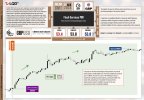
USD – Flash Manufacturing PMI
This index is calculated from a monthly survey of approximately 800 purchasing managers in the manufacturing sector and serves as a key barometer for industry health and economic direction. Typically conducted in the third week of each month, the survey results in two releases: the Flash and the Final report, with the Flash version, launched in May 2012, generally more influential due to its timeliness. A PMI above 50 indicates expansion within the industry, whereas a reading below 50 denotes contraction. As a vital leading economic indicator, this index provides immediate insights into current business conditions such as employment, production, new orders, prices, supplier deliveries, and inventory levels, showcasing the quick responsiveness of purchasing managers to changing market dynamics.
In March 2024, the S&P Global Flash US Manufacturing PMI initially indicated a robust improvement in the sector, recording a 21-month high of 52.5, up from February’s 52.2, signaling strong gains in output and employment. However, this figure was later revised down to 51.9. Despite the downward revision, the manufacturing sector continued to drive US economic expansion, with production hitting a 22-month high and job creation rates accelerating. The original surge was partly due to strategic adjustments in inventory and purchasing activities, with firms reducing stocks more sharply than at any point since the previous November to manage costs and improve cash flow. This scaling back of inventories coincided with the fastest rise in input costs in six months, leading to significant increases in selling prices—the most substantial in nearly a year. While challenges such as inflationary pressures persist, the sector remains a cornerstone of the broader economy’s strength, with ongoing optimism supported by expectations of continued economic improvement, strategic marketing, and enhanced capacity.
TL;DR
| Metric | Detail |
| PMI Score | Revised to 51.9 from initial 52.5, still a robust indicator of sector improvement |
| Previous Scores | Up from February's 52.2, reaching a 21-month high |
| Production & Employment | Production at a 22-month high, with accelerated job creation rates |
| Inventory & Purchasing | Strategic reductions in stock to manage costs, sharpest since previous November |
| Input Costs & Prices | Fastest rise in input costs in six months, leading to significant increases in selling prices |
| Economic Role | Sector remains key to US economic expansion, despite challenges like inflation |
| Optimism & Strategy | Supported by expectations of continued economic improvement, strategic marketing, and capacity |
The forecast for
Flash Manufacturing PMI indicates a value of
52, slightly higher than the previous outcome of
51.9.
The last time, the
US Flash Manufacturing PMI was announced on the 21st of March, 2024. You may find the market reaction chart
(US500 M5) below:
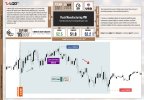
USD – Flash Services PMI
This index, derived from a monthly survey of around 400 purchasing managers, assesses the economic health of the service sector through a diffusion index. Conducted typically in the third week of each month, a score above 50 on this index indicates expansion, whereas below 50 suggests contraction. The index is published in two editions, “Flash” and “Final,” with the “Flash” version, launched in November 2013, often having a greater impact due to its earlier release. As a critical economic indicator, this index quickly captures business responses to changing market conditions, providing essential insights from purchasing managers on various business aspects such as employment, production, new orders, prices, deliveries, and inventories.
In March 2024, the U.S. Services Sector saw a slowdown in growth, with the Flash U.S. Services Business Activity Index falling to a three-month low of 51.7 from February’s 52.3, according to S&P Global. Despite this, the manufacturing sector experienced significant growth, with the Flash U.S. Manufacturing Output Index reaching a 22-month high of 54.9, helping to keep the overall U.S. business activity robust with a Composite Output Index of 52.2. Employment rates and business confidence soared, hitting the highest levels of 2024, driven by positive economic forecasts and expansion plans. However, the economy faced challenges from rising inflationary pressures, with input costs increasing at the fastest rate in six months and selling prices seeing the sharpest inflation in nearly a year. Chris Williamson of S&P Global highlighted the resilience of the U.S. economy, supported by ongoing growth in both manufacturing and services, though the service sector’s growth has moderated amidst aggressive Federal Reserve rate hikes.
TL;DR
| Sector/Index | Detail |
| Services Business Activity Index | Fell to 51.7, a three-month low, from February's 52.3 |
| Manufacturing Output Index | Significant growth to a 22-month high at 54.9 |
| Composite Output Index | Remained robust at 52.2 despite service slowdown |
| Employment & Confidence | Employment rates and business confidence at 2024 highs, driven by positive economic forecasts |
| Inflation Challenges | Input costs and selling prices increased sharply, fastest rate in six months and nearly a year, respectively |
| Economic Overview | Chris Williamson highlighted the U.S. economy's resilience with growth in manufacturing and services despite service moderation |
The forecast for
Flash Services PMI suggests a reading of
51.8, a marginal increase from the previous outcome of
51.7.
The upcoming
Flash Manufacturing and
Services PMI is set to be released on
Tuesday at
1:45 PM GMT.
The last time, the
US Flash Services PMI was announced on the 21st of March, 2024. You may find the market reaction chart
(GBPUSD M5) below:
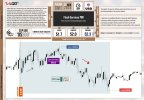
USD – New Home Sales
The Annualized New Home Sales metric reports the monthly sales of new single-family homes, projected on an annual basis and released on the 17th business day after the month ends. This indicator is crucial for traders as it acts as a leading measure of economic health. The sale of a new home triggers a wide-ranging economic activity, including the purchase of home furnishings and appliances, mortgage issuance by financial institutions, and payments to brokers who facilitate these transactions. As such, this metric plays a key role in evaluating the overall economic condition.
In their latest report, the U.S. Census Bureau and the Department of Housing and Urban Development revealed that February 2024 witnessed a slight dip in new single-family home sales to a seasonally adjusted annual rate of 662,000, just below January’s revised figure of 664,000. Despite this minor decrease, sales have surged by 5.9% compared to February of the previous year, closely mirroring pre-pandemic sales levels. The inventory of unsold new homes has slightly increased to 463,000, indicating an 8.4-month supply at the current sales pace, a figure that significantly exceeds the typical market equilibrium range of 4 to 6 months. This data suggests a larger-than-normal stockpile of homes available for sale, categorically broken down into homes not yet started, those under construction, and completed units—a classification method adopted by the Census Bureau since 1973.
TL;DR
| Metric | Details |
| Sales Rate | February sales at a seasonally adjusted annual rate of 662,000; slight decrease from January’s 664,000 |
| Yearly Comparison | Sales increased by 5.9% compared to February of the previous year |
| Inventory Levels | Inventory of unsold homes rose to 463,000, indicating an 8.4-month supply at current sales pace |
| Supply Context | Current supply significantly exceeds the normal market equilibrium of 4 to 6 months |
| Inventory Breakdown | Homes categorized as not yet started, under construction, and completed units |
| Historical Context | Classification method has been used by the Census Bureau since 1973 |
The forecast for
New Home Sales indicates
68,000 units, compared to the previous figure of
662,000 units.
The next
New Home Sales is scheduled for release on
Tuesday at
2:00 PM GMT.
USD – Richmond Manufacturing Index
The Richmond Manufacturing Index is a composite measure generated from a survey of around 55 manufacturers in the Richmond area. It is released monthly on the fourth Tuesday of each month. This index assesses various business conditions such as shipments, new orders, and employment. Values above 0 signify improving conditions, while those below 0 suggest deterioration. Although the index provides valuable insights, its impact is typically limited because of the existence of earlier regional manufacturing indicators.
In March, the Federal Reserve Bank of Richmond reported a slowdown in Fifth District manufacturing activity, with the composite manufacturing index dropping from -5 in February to -11. This decline was led by significant drops in shipments, new orders, and a stagnation in employment levels. Despite mixed feelings about current local business conditions, firms showed increased optimism for future prospects. However, challenges persisted with declining backlogs, negative vendor lead times, and a sharp fall in capacity utilization. Additionally, both the growth rates of prices paid and received by firms decreased, with expectations for these rates to further moderate in the coming year.
TL;DR
| Metric | Details |
| Composite Index | Dropped to -11 from February’s -5 |
| Key Components | Significant drops in shipments, new orders; stagnation in employment levels |
| Local Business Conditions | Mixed current feelings but increased optimism for future prospects |
| Operational Challenges | Declining backlogs, negative vendor lead times, sharp fall in capacity utilization |
| Prices | Decreased growth rates of prices paid and received; expectations for further moderation |
The forecast for the
Richmond Manufacturing Index indicates a value of
-8, an improvement from the previous outcome of
-11.
The next
Richmond Manufacturing Index is set to be released on
Tuesday at
2:00 PM GMT.
Disclaimer: The market news provided herein is for informational purposes only and should not be considered trading advice.

